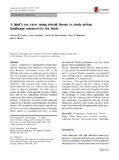JavaScript is disabled for your browser. Some features of this site may not work without it.
| dc.contributor.author | Grafius, Darren Ronald | |
| dc.contributor.author | Corstanje, Ronald | |
| dc.contributor.author | Siriwardena, Gavin M. | |
| dc.contributor.author | Plummer, Kate E. | |
| dc.contributor.author | Harris, Jim A. | |
| dc.date.accessioned | 2017-08-30T14:54:51Z | |
| dc.date.available | 2017-08-30T14:54:51Z | |
| dc.date.issued | 2017-06-28 | |
| dc.identifier.citation | Grafius DR, Corstanje R, Siriwardena GM, et al., (2017) A bird’s eye view: using circuit theory to study urban landscape connectivity for birds. Landscape Ecology, Volume 32, Issue 9, September 2017, pp. 1771-1787 | en_UK |
| dc.identifier.issn | 0921-2973 | |
| dc.identifier.uri | http://dx.doi.org/10.1007/s10980-017-0548-1 | |
| dc.identifier.uri | http://dspace.lib.cranfield.ac.uk/handle/1826/12406 | |
| dc.description.abstract | Context Connectivity is fundamental to understanding how landscape form influences ecological function. However, uncertainties persist due to the difficulty and expense of gathering empirical data to drive or to validate connectivity models, especially in urban areas, where relationships are multifaceted and the habitat matrix cannot be considered to be binary. Objectives This research used circuit theory to model urban bird flows (i.e. ‘current’), and compared results to observed abundance. The aims were to explore the ability of this approach to predict wildlife flows and to test relationships between modelled connectivity and variation in abundance. Methods Circuitscape was used to model functional connectivity in Bedford, Luton/Dunstable, and Milton Keynes, UK, for great tits (Parus major) and blue tits (Cyanistes caeruleus), drawing parameters from published studies of woodland bird flows in urban environments. Model performance was then tested against observed abundance data. Results Modelled current showed a weak yet positive agreement with combined abundance for P. major and C. caeruleus. Weaker correlations were found for other woodland species, suggesting the approach may be expandable if re-parameterised. Conclusions Trees provide suitable habitat for urban woodland bird species, but their location in large, contiguous patches and corridors along barriers also facilitates connectivity networks throughout the urban matrix. Urban connectivity studies are well-served by the advantages of circuit theory approaches, and benefit from the empirical study of wildlife flows in these landscapes to parameterise this type of modelling more explicitly. Such results can prove informative and beneficial in designing urban green space and new developments. | en_UK |
| dc.language.iso | en | en_UK |
| dc.publisher | Springer | en_UK |
| dc.rights | Attribution 4.0 International | |
| dc.rights.uri | http://creativecommons.org/licenses/by/4.0/ | |
| dc.subject | Circuitscape | en_UK |
| dc.subject | Connectivity | en_UK |
| dc.subject | Circuit theory | en_UK |
| dc.subject | Urban | en_UK |
| dc.subject | Parus major | en_UK |
| dc.subject | Cyanistes caeruleus | en_UK |
| dc.subject | Landscape structure | en_UK |
| dc.subject | Ecosystem service | en_UK |
| dc.subject | Modelling | en_UK |
| dc.title | A bird's eye view: using circuit theory to study urban landscape connectivity for birds | en_UK |
| dc.type | Article | en_UK |
Files in this item
This item appears in the following Collection(s)
-
Staff publications (SWEE) [2815]

